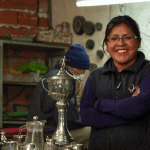Philanthropy is Shortchanging Climate Change: Here Are Three Ways It Can Boost Its Impact
There’s no question about it: Climate change is a hot topic—and not just because of the wildfires that tore through California this fall and are currently devastating Australia. Between Greta Thunberg’s historic appearance before the UN, pushback surrounding President Trump’s decision to formally withdraw from the Paris Climate Agreement, and the debate over the Green New Deal in Congress, awareness about the climate crisis—and discussion of potential solutions—is growing.
Unfortunately, philanthropy hasn’t followed suit: When it comes to charitable giving, climate lags behind other issues. Certainly, there have been some notable gifts—such as Stewart and Lynda Resnick’s record $750 million gift to the California Institute of Technology for research focused on energy infrastructure, climate science, sustainable water management and global ecology.
But such gifts are the exception. In England, a group of scientists virtually begged the country’s wealthiest families to fund more climate research, noting that less than 3% of philanthropic giving goes to climate-related issues. (Globally, that number may actually be worse—it was less than 2% in 2015, by some estimates.) Meanwhile, forests are burning, sea levels are rising, and our window for taking action is getting smaller by the day.
So why the philanthropic inertia? There’s no single reason. But in my experience bringing family offices, foundations and philanthropies to the climate investment table, I’ve found that many struggle with how abstract “solving climate change” can feel—especially when compared to more traditional philanthropic causes, like curing a rare disease that has altered the life of a loved one.
Others want evidence that their philanthropic gift is definitely going to make a difference, which can be hard to demonstrate when the goal of their donation is to advance climate-friendly policies (a very typical and necessary philanthropic climate intervention). For example, a major leading philanthropy that relies on data to maximize the impact of every dollar given notably left climate off its priority issues list. Why? Other issues were “more tractable.”
Even so, philanthropists and foundations are still looking for ways to engage on climate. They know it’s a big problem and want to make a difference. But they don’t know where to start.
One under-resourced area is climate innovation: i.e., the development of clean technologies with game-changing potential, from clean energy solutions to climate change mitigation and carbon capture technologies. When it comes to supporting nascent businesses and entrepreneurs in this sector—as a gift or an investment—here’s what I tell prospective donors:
Philanthropists Should Start Today to Support the Clean Energy Technologies of Tomorrow
I often hear: “Why fund early-stage clean technologies now when they’ll be better in 10 years?” And of course, technology will be better in 10 years. But unlike, say, mobile technology, clean tech takes many years to develop, requiring support, training… and yes, patience.
Every breakthrough today makes these long-term solutions more likely. In November we saw a company called Heliogen announce that it had discovered a way for mirrors and AI to create “solar ovens” that can create enough heat to produce industrial products like steel and cement. This could dramatically reduce the greenhouse gas emissions typically required to make these products (the production of cement alone is responsible for 7% of global CO2 emissions). And in agriculture there are countless entrepreneurs developing clean, climate-positive technologies. These innovations are tackling everything from reducing carbon loss through better soil management in farming to exploring whether bacteria can be engineered to reduce methane emissions from cattle—to say nothing of the technologies coming down the pike in clean energy and transportation
But to enable these breakthroughs, we need to start now.
To Boost Climate Innovation, Philanthropy Must Embrace Risk
Most philanthropies working on climate today know a lot about how government works. As a result, they often focus on the policy of climate action—such as educating policymakers in support of renewable energy standards—rather than the complementary innovation and financing that achieving climate-positive goals requires.
But to make a difference, they should also add in support for climate innovation and finance, even if it means adding a little risk to their portfolios with investments that take longer to show results — or that may not pan out at all. That’s one reason I’ve worked closely with Prime Coalition, a nonprofit that partners with philanthropists and facilitates catalytic investments in ventures that address climate change. One of Prime’s first investments was in a company called Quidnet Energy, which is developing a breakthrough, grid-level technology to deliver energy storage services at 10% of the cost of other technologies. Thanks to Prime’s seed round, Quidnet was able to take the technology from concept to field test—a critical stop on the way to commercial implementation. Its most recent round of funding was led by Breakthrough Energy Ventures, launched by Bill Gates, Jeff Bezos, Richard Branson, Mark Zuckerberg and George Soros. This kind of early-stage support from philanthropy could give a similar boost to other promising new climate tech companies, helping them bridge the gap to larger-scale investment.
When Supporting Climate Tech, Philanthropists Must Learn While They Give
Philanthropies rightfully care a lot about understanding an issue through and through. With climate, that can be challenging, and the science can be complex. But here’s what we do know: The climate crisis is an existential threat. And as 2030 approaches, changing our climate trajectory becomes more and more difficult with every passing year. We need to learn—but we don’t have the luxury of waiting until we’ve mastered the issue: We need to learn while we give.
We can help entrepreneurs learn as well. I serve on the board of Activate, which has provided stipends to more than 50 fellows to allow them to focus full-time on everything from next-generation, sustainable manufacturing technology to innovative methods for increasing food production with less waste. The cost of the fellowship comes out to about $500,000—it covers two years of living expenses, health insurance and travel (among other things), so fellows can get the training they need to commercialize and connect with potential investors or partners. Almost every fellow I’ve spoken with has told me the same thing: “Without this fellowship, I wouldn’t have pursued this technology.” This sort of approach could prove invaluable in enabling the brightest minds in climate science to take their innovations from concept to reality.
There’s much that we don’t know about the climate crisis, but one thing is clear: Solving it will require more innovators, more entrepreneurs and more financing. By giving consistently, providing patient capital and embracing a little risk, philanthropists can create meaningful change. There’s no reason to wait.
Nicole Systrom is the founder of Sutro Energy Group.
Photo courtesy of Chris Boese.
- Categories
- Environment, Technology



